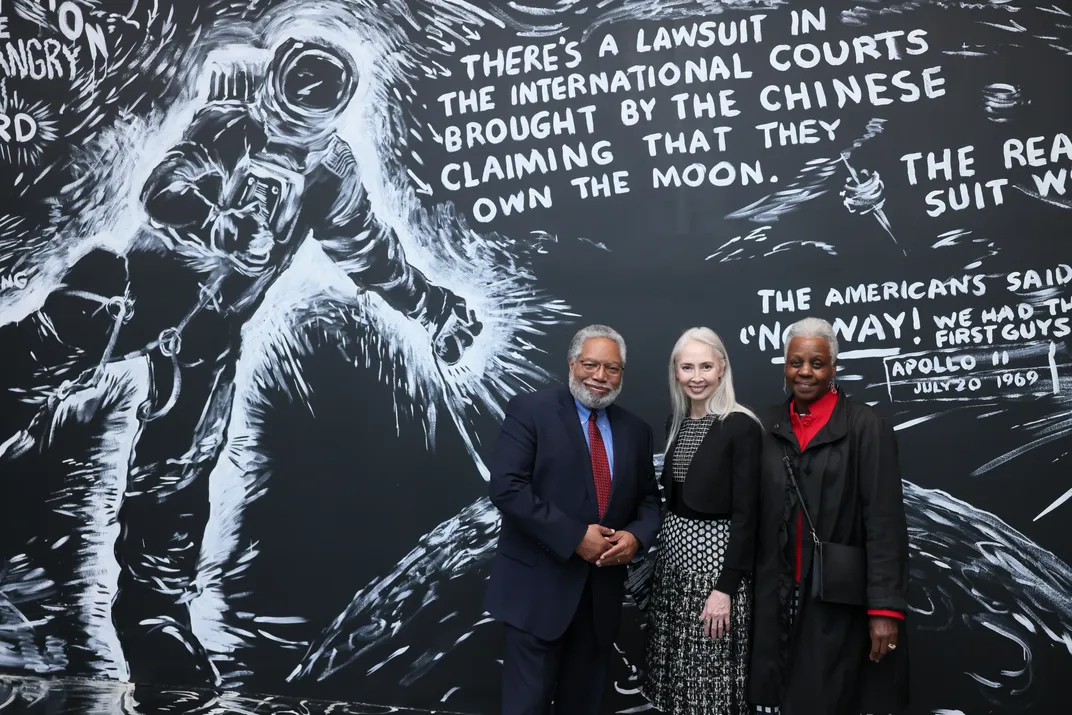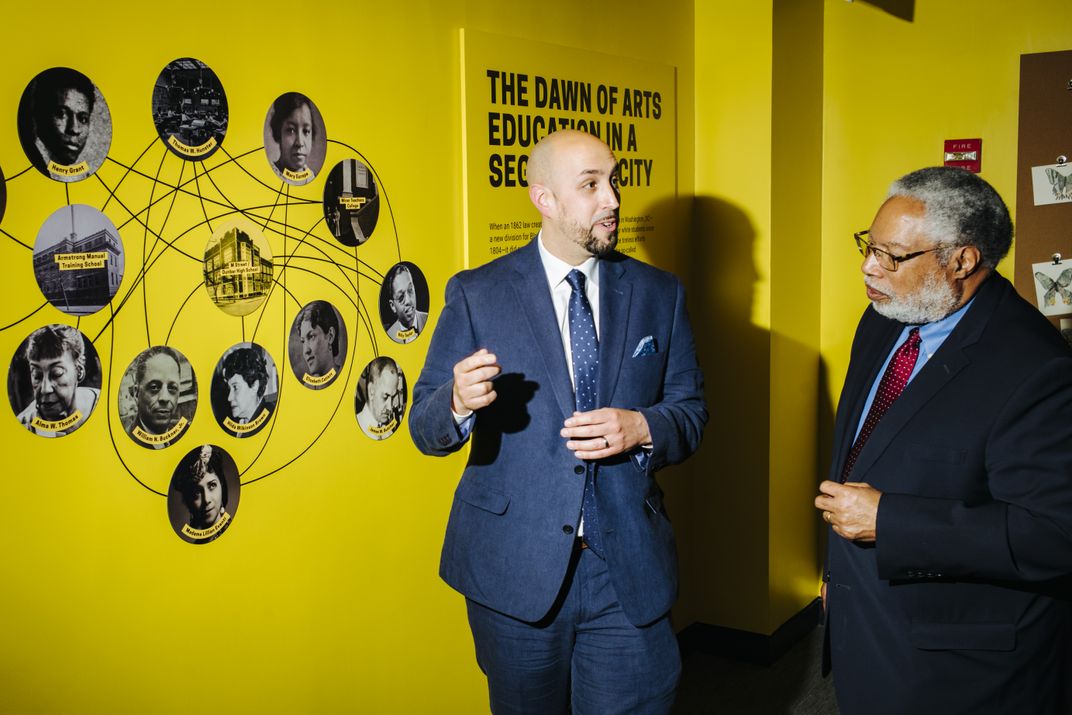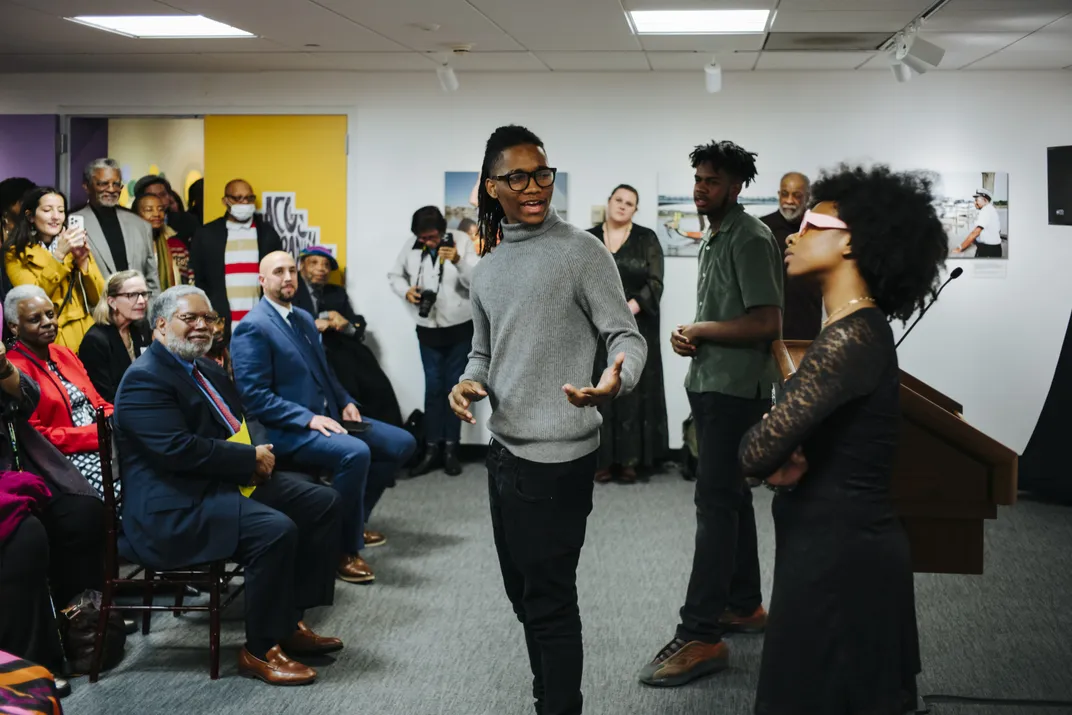OFFICE OF THE SECRETARY OF THE SMITHSONIAN
Tracing a Century of History Through Art
The Hirshhorn and the Anacostia Community Museum both opened stunning and distinct exhibitions with unexpected parallels this March.
:focal(3648x2432:3649x2433)/https://tf-cmsv2-smithsonianmag-media.s3.amazonaws.com/filer_public/43/06/4306abba-e919-4069-bf6e-4f98e57df9ff/melissa_chiu_lonnie_bunch.jpg)
On a Friday night in March, I found myself at back-to-back exhibition openings: the Hirshhorn’s 50th anniversary show Revolutions: Art from the Hirshhorn Collection, 1860-1960 and A Bold and Beautiful Vision: A Century of Black Arts Education in Washington, DC, 1900-2000 at the Anacostia Community Museum.
Shuttling from one museum to the next felt like traveling along the full spectrum of pointedly unique work happening at the Smithsonian. I joined the art historians, artists, and collectors walking through the Hirshhorn’s exhibition, marveling at the art from across the globe which has its roots in a once-private collection. At the Anacostia Community Museum, I was struck by the sense of community ownership over an exhibition that pays homage to the cultivation of artistic talent in Washington’s schools.
In many ways, these exhibitions appear unconnected, two disparate areas of focus. And yet both reflect intergenerational conversations among artists, whether abstract or literal. Both trace a century of history and tell that story through art. Both prove that no one artist or work exists in a vacuum: these exhibitions reveal the interconnected nature of the art world and artistic community—and the Smithsonian itself.
Both prove that no one artist or work exists in a vacuum: these exhibitions reveal the interconnected nature of the art world and artistic community—and the Smithsonian itself.

Revolutions may be the most moving use of the Hirshhorn’s collections I have ever seen. To mark the museum’s fiftieth anniversary, co-curators Marina Isgro and Betsy Johnson set about the daunting task of culling an exhibition from the museum’s collection—including the 12,600 objects that Joseph Hirshhorn gifted to the nation, which prompted the museum’s creation. Revolutions places more than 200 artworks from 1860-1960 in conversation with contemporary pieces.
The exhibition spans an entire floor of the museum and is the first of a series of three: Revolutions covers the birth of modernism and the rise of abstraction, loosely in chronological order. Subsequent exhibitions will cover the history of art using the permanent collection after 1960.
Curator Marina Isgro describes the show as being “about both the iconic favorites of the Hirshhorn’s collection and some lesser known but very interesting highlights.” The result is a stunning blend of the most famous artists in the collection—the likes of Alberto Giacometti, Willem de Kooning, Jacob Lawrence, and David Smith—alongside pieces that have rarely been on view. Joseph Hirshhorn collected work by mid-century Haitian painters and recognized talent in artists like Emily Carr and Aleksandra Exster whose posthumous fame was still decades away.
As Hirshhorn Director Melissa Chiu puts it, “the show is really grounded in this idea of telling history through art. We set about to include some contemporary voices, knowing that there are substantial gaps in our collection because it had its life first as a private collection.”
One such intervention is the inclusion of a large action painting made by Janet Sobel in 1945 that hangs alongside one made by Jackson Pollock in 1949. Sobel was a Ukrainian-American artist who created The Attraction of Pink by dripping paint over her canvas. Her style and technique were groundbreaking, yet her work is routinely absent from the cannon, overshadowed by Pollock’s association with works of a very similar style—one he adopted in 1947.
The exhibition is punctuated by unexpected pairings designed to help us look more closely at the history of artistic expression. Historic works, many from Joseph Hirshhorn’s foundational gift, are juxtaposed with contemporary pieces set against brightly colored backdrops. The first of these pairings introduces the exhibition. On the right is John Singer Sargent’s 1884 portrait Mrs. Kate A. Moore; beside it is Amoako Boafo’s 2020 painting Cobalt Blue Dress.
/https://tf-cmsv2-smithsonianmag-media.s3.amazonaws.com/filer_public/5c/be/5cbe74c8-30e2-443e-8a6c-eaabbd7c42a6/hmsg_revolutions.jpeg)
Sargent’s portrait is typical of 1800s portraiture: it is a commissioned work of a Parisian socialite, a full-body image intentionally made to be flattering. Boafo’s work is also a portrait of a woman, but a more abstract depiction of a Black woman in a striking blue dress. The colors have been painted in thick swirls done by a gloved hand. It is a technique reminiscent of Oskar Kokoschka, a portrait artist for the Viennese elite at the turn of the 20th century, whose work is also included in the show.
While Boafo is not directly alluding to Kokoschka, intergenerational nods like these knit the show together. As curator Betsy Johnson puts it: “Artists are processing experience […] we see them return to some of the same themes over and over again. Each time, there’s a shift because the times have changed […] but each time it’s the same.” Johnson explains that the show’s title is a nod to the circular nature of history, where change and continuity can coexist and even reinforce each other. Whether consciously or not, the works are in conversation with one another.

At the Anacostia Community Museum, curator Samir Meghelli describes A Bold and Beautiful Vision as a deeply communal project. “In so many exhibitions, we celebrate the singular genius of an artist, and this exhibition is really about the genius of the collective and the brilliance of the community,” he says. “As much as we may celebrate Alma Thomas or Duke Ellington or Elizabeth Catlett in a singular sense, rarely do we ask: who were their teachers and mentors? Who helped cultivate their skills, and in turn, whose did they help cultivate? That is the tradition and lineage we are hoping to honor with this exhibition.”
“As much as we may celebrate Alma Thomas or Duke Ellington or Elizabeth Catlett in a singular sense, rarely do we ask: who were their teachers and mentors? Who helped cultivate their skills, and in turn, whose did they help cultivate?" says curator Samir Meghelli.
The exhibition is among the most original the museum has ever had: it takes us behind the scenes of arts education in the nation’s capital. The gallery opens with the story of Thomas Hunster, the man who created the arts curriculum for African American schools in Washington, D.C., in the late 1800s. His curriculum—highly innovative for its time—was later adopted district-wide.
Hunster taught in segregated Washington for nearly 50 years; his students included the likes of Alma Thomas, William Buckner Jr., and James W. Butcher Sr. Works he produced in collaboration with students at M Street High School (later known as Dunbar High School) were featured at the World’s Fair in Paris in 1900, then at the 1901 Pan-American Exposition in Buffalo, New York, and finally at the 1907 Jamestown Tercentennial. This exhibition, however, is the first time his educational and artistic legacy has been recognized at scale, despite his foundational impact.
After Hunster’s retirement, the renowned artist Elizabeth Catlett attended Dunbar High School and took classes shaped by Hunster’s curriculum. She credits Dunbar as the place she realized she wanted to be an artist. Years after her graduation, some of her works hung in the hallways of her alma mater and served as an inspiration for the next generation of students—including the original prints from her first solo exhibition. That series of prints, titled The Black Woman, now hangs at the Anacostia Community Museum.
Walking through the exhibition, I was especially moved by a sketch of a young James Baldwin done by David Driskell shortly after he graduated from Howard University. Just weeks before Driskell’s graduation, James Baldwin spent time on campus to stage his then-unpublished play The Amen Corner as a student production. This early crossover is so striking because, as Meghelli put it, both were “aligned in their thinking around the necessity of understanding and embracing African American culture in order for America to achieve anything resembling progress.”
It is a conviction held by every artist in the exhibition: in classrooms first segregated by law and later by social custom, artists taught, mentored, and encouraged one another. It is because of the strength of that community that these renowned artists had such lasting individual impact.
That community lives on today: the exhibition ends with the recent history of Duke Ellington School of the Arts; the opening ceremony included a memorable performance by current students. There is space for visitors to write about teachers who inspired them and leave their stories on the gallery wall. On opening night, the sense of community ownership was palpable: this is a history unique to Washington, and it is the context in which arts education continues in the District of Columbia.

Both A Bold and Beautiful Vision and Revolutions emphatically make the case that art happens in community, and that artists are continually in conversation with one another. These exhibitions span major historical events—in the case of Revolutions, two World Wars; in A Bold and Beautiful Vision, school desegregation—and yet the nonlinear relationships among artists remain steadfast, so that they might sustain and cultivate new talent. Artists enable each other to enshrine history in art, even and especially when history begins to repeat itself. As Johnson put it, paraphrasing the philosopher Søren Kierkegaard: “there is so much progress that happens through repetition.”